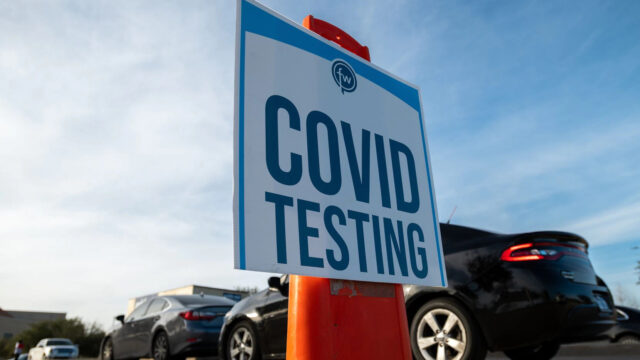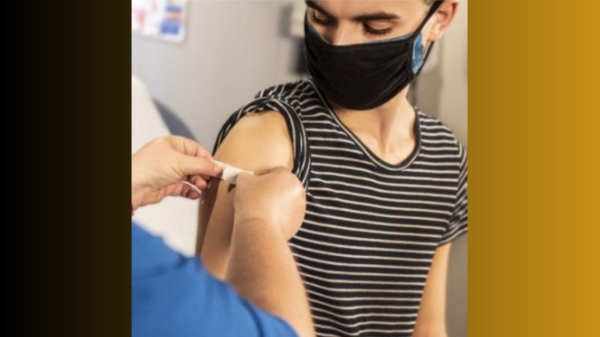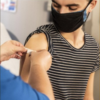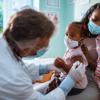By Sriya Reddy and Imelda García

When she received a negative COVID rapid test at the end of December, Sarah Sedaghatzadeh trusted it. Last summer, Sedaghatzadeh had a viral infection that a doctor told her wasn’t COVID-19. She thought that her feeling ill was a repeat of that.
Two days later, she learned that she was positive for COVID-19 after taking a PCR test. She realized that she gave COVID-19 to her entire family, including her mother, pregnant sister, brother-in-law and her boyfriend.”
“It’s the worst feeling in the world I’m telling you right now,” she said. “I spread it to everybody in my family. And, I mean, it sucks.”
As the omicron variant surges in North Texas and around the country, more people are relying on rapid tests to determine whether it’s safe to see family and friends. Especially over the holidays, those traveling to see family often waited in long lines to get tested for COVID before going ahead with their plans.
However, the FDA last month cautioned that the rapid antigen tests may be less sensitive to the new variant, especially in the early days of infection, following an analysis of several types of tests, conducted in conjunction with the National Institutes of Health.
That is sowing confusion, and at times, regret among some who relied on the tests’ accuracy. Experts say that patients should not ignore symptoms even if they have a negative rapid test. Sometimes, further testing may be needed.
While the rapid antigen tests detect proteins on the coronavirus, the more sensitive PCR tests detect the viral RNA instead. Rapid test results come back quickly, while PCR tests can sometimes take days.
In the past, Sedaghatzadeh, who interned at The News in the fall, said that both her PCR test and rapid test came out negative. So when her rapid test came out negative, she assumed that the same thing would happen this time.
After a bout with COVID, Sedaghatzadeh and her family are now fully recovered.
For Sedaghatzadeh, this experience made her be more careful than ever.
“Now I’m just like, masks everywhere even though I’m vaccinated,” she said. “I just want to be more precautious now. And if I’m feeling slightly sick now I’m like, don’t risk it. Even if it says negative, don’t risk it. I think that’s my biggest learning lesson in all this.”
Hafsa Irfan has the same take away after she tested negative for a rapid and PCR test mid-December.
“I learned that if you have any sort of symptoms, even if it’s small, especially since omicron symptoms are very cold-like symptoms, and you know you’ve been exposed, I would definitely just stay at home and quarantine and kind of stay away from people,” she said.
After being exposed, Irfan was able to get a rapid test and two PCRs. The first rapid and PCR came out negative, but her second PCR, which she took 20 minutes after the first one, was positive.

She was surprised because her symptoms were mild.
“At first, I was really confused because my sore throat kind of went away in a day. So I was like, ‘oh, there’s no way I have it,’ like I don’t feel anything, Irfan said. “But you can definitely still carry it.”
Dr. Philip Huang said that rapid antigen tests are a convenient tool, but not as reliable as a PCR test. He said that you can trust a positive result, but a negative result doesn’t always mean you’re negative for COVID.
“If you had a negative because of the false negatives then it just means the test didn’t come back positive, it doesn’t mean that you might not come back positive the next day or later when it’s repeated. So you still need to take precautions.”
Antigen tests are not as effective in detecting omicron as they have been with the other variants, explained Carla Garcia Carreño, chief of Infectious Diseases at Children’s Medical Center Plano.
“There are times when a rapid test can be negative. The antigen test performed well with delta, but it is a little less efficient in detecting omicron because of all the mutations the virus has had,” she explained.
Huang said that the increase in false negatives may be because of the increase in testing due to the holidays and the spread of the omicron variant.
“There’s increased demand because more people are having symptoms and needing the test,” Huang said.
Huang said that if you are experiencing symptoms and test negative, taking the more sensitive PCR test would be the best next step.
“It needs to be used appropriately and interpreted appropriately,” Huang said. “It’s one tool that we have, it’s not perfect, and that’s where we hope it doesn’t give them a false sense of security.”









You must be logged in to post a comment Login